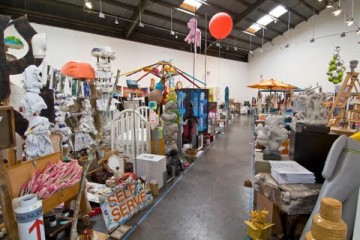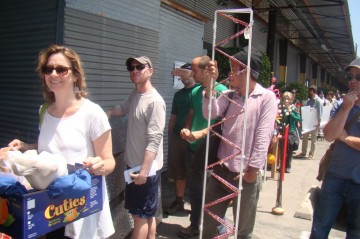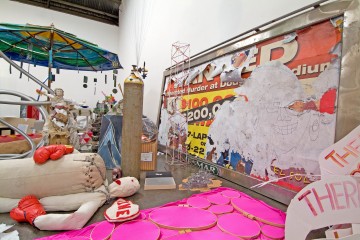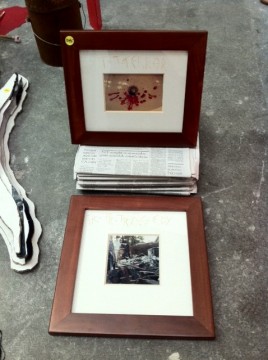
"Chain Letter" installation view at Shoshana Wayne Gallery, July 2011. Courtesy Shoshana Wayne Gallery.
Did you receive any unusual email forwards this month? Unrelated to funny cats? Initially sent out by Christian Cummings and Doug Harvey, a chain letter has been circulating among artists and art enthusiasts, inviting recipients to participate in an exhibition. In addition, each recipient was to invite 10 artists who they admired, to participate in the same exhibition. The resulting shows are popping up all over the world this month—in Zürich, Berlin, Boston, London, San Francisco, Philadelphia, Johannesburg, Seoul, Paris, and last but not least, here in Los Angeles. The latter Chain Letter manifestation was the largest of them all, which just opened at Shoshana Wayne Gallery at Bergamot Station, and features close to 1,600 artists.
Harvey and Cummings facilitated a Chain Letter show four summers ago at a smaller gallery, High Energy Constructs in Chinatown, with a similar curatorial principle. That chain letter invite circulated for only 10 days, and resulted in an exhibition of 300 art works. This time, Cummings and Harvey sent the letter more than one month in advance, allowing the tree of curators to fork ever more broadly. Having thoroughly enjoyed participating in the 2006 version, I was eager to fuel the wildfire of this year’s incarnation. But for reasons too boring to blog, I ended up missing the drop-off day—and apparently also missing a raucous block party. The line of artists delivering work snaked around multiple buildings at bergamot, through the parking lot, and out the gate with some artists waiting up to three hours to install their pieces. But by all accounts the mood was jovial and cooperative—how could it be otherwise? Each artist in line knew that he or she bore some responsibility for the chaos–tenfold. By midday, Shoshana Wayne’s vast rooms were already chock full, and the organizers opened two vacant gallery spaces to accommodate the extensive overflow.

Artists waiting to install work for "Chain Letter" at Shoshana Wayne Gallery, Bergamot Station, Santa Monica, CA. Photo: Tanya Ragir.
Bergamot Station was again overrun by Chain Letter-ers at the opening reception. More and more lines formed; the galleries now chock full of art, could only accommodate a handful of viewers at a time. And what about all that art?
Perhaps a product of the single constraint of “no wall work,” 3-D pieces dominate the scene. In particular, combine-like conglomerations rule—which simultaneously enhance the dizzyingly chaotic atmosphere, while establishing continuity. Yet even within this realm, there was a broad range of approaches, from craft-inspired sewn sculptures to reconfigured detritus. Remember Protest by duo Jeff&Gordon consists of a junk-shrine—a possibly pilfered “End of Road Work” orange construction sign stands upright, while Virgin Mary candles, latte cups, fake flowers, car air freshener trees, and an overturned toy truck surround the base of the sign. Immediately to the left, a pile of three bricks prop a cement slab against the wall. The words “As I was” are scrawled into the slab. While it shares the combine-esque quality of its neighbor, but the contemplative, handwritten text disrupts the castoff quality of the materials.

"Chain Letter" installation view at Shoshana Wayne Gallery, July 2011. Courtesy Shoshana Wayne Gallery.
Of course there won’t be 1600 artworks in one show without a couple “oh my god we are wearing the same dress!” moments. For example, two different modified patio umbrellas were erected. Instead of fighting against their commonality, the artists elected to install their umbrellas next to one another. Likewise, a gold spray-painted lawnmower sits a few feet from a similarly spray-painted broom and dustpan set. Certainly, the entropic spirit and circumstances of the Chain Letter may have attracted artists already engaging in a Dada-esque tradition, while encouraging those who typically make more precious art to explore disposable materials. In an email, Harvey responded to my observation about the readymade aesthetic that characterizes many of the pieces. “I think a lot of people put in works that they didn’t mind getting knocked around or even thrown out at the end of the show. That accounts for some of it. I’m not sure if there’s a larger trend in evidence. Except I do believe that the collage/assemblage aesthetic is highly underestimated both art historically and in terms of its ongoing impact on practicing artists, and when there’s no filter to exclude it, its real predominance becomes more obvious.”
Still, there were plenty of more traditional– and representational– sculptural practices in effect. One figurative sculpture—a Venus-of-Willendorf-esque cement figure, lying face down caught my eye. And apparently the piece, entitled Damon by David Grant, caught the eye of a patron, as its label was adorned with a rare red-dot soon after the opening. Alyssa Casey’s understated sculpture, Untitled (my foot), an upright foot and ankle carefully constructed from molded strips of handmade paper, provides another rare moment of delicacy.

Roya Falahi, "T-T-Terror, Tr-Tr-Tragedy," 2011, Framed C-prints, with carved mats, and newspaper, dimensions variable. Courtesy Roya Falahi.
Despite the floor-only edict, a few videos and performances popped up, and plenty of photographs, paintings, and drawings found their way into Chain Letter, displayed on canvases on pop-up easels, or propped against walls, pedestals, or other works. Lynn Berman constructed a large stacking armature, on which artists could hang their 2D pieces. Berman further embraced the cooperative inclusive spirit of Chain Letter by driving a school bus full of participants and fans to the opening reception.
I asked the instigators (they renounce the title of “curator”) if they contributed their physical artworks. “Yes,” says Cummings, who played by his own rules. “Doug [Harvey] actually invited me as one of his 10 invites.”
Harvey deflects, serving back a refrain uttered by countless would-be participants: “I brought a piece but didn’t want to wait in line.”

"Chain Letter" installation view at Shoshana Wayne Gallery, July 2011. Courtesy Shoshana Wayne Gallery.




Pingback: “Chain Letter” at Shoshana Wayne Gallery « Scott Tsuchitani
Pingback: i heart my chains | art is all we have